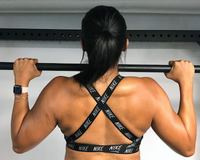Seated Knee Tucks
Also known as the reverse crunch, the seated knee tuck is an essential part of any core workout routine.
If you want to build six pack abs or simply increase your core strength, seated knee tucks are for you!

Muscles Worked By Seated Knee Tucks
Primary Muscle Groups:
When you think about exercising your “abs,” you usually focus on building muscle in the rectus abdominis. This muscle makes up the prototypical “six pack abs” that dominate the cover of nearly every fitness magazine.

Although the rectus abdominis is one muscle, it is possible to target specific areas of the muscle more optimally.
In this case, seated knee tucks primarily emphasize the bottom part of the rectus abdominis, also known as your “lower abs.”
Secondary Muscle Groups:
Seated knee tucks work a variety of other secondary muscles. The transverse abdominis, the deepest muscle of your core, activates to stabilize your mid-section.
Your quads and hamstrings also work to flex and extend your legs. In addition, your hip flexor muscles activate to support your hips throughout the exercise motion.
Seated Knee Tucks Benefits
1. Improved Core Strength
Seated knee tucks directly target your abdominal muscles. As a result, consistent training will help you build a stronger core.
Core strength is important for nearly every single exercise. If you want to improve your performance at compound lifts, you must first build a sturdy core.
Whether you are throwing a ball, lifting weights and heavy objects, or you simply want to get those six pack abs, seated knee tucks will help accomplish your goals.
2. Improved Posture
Many people are surprised to learn that an anterior pelvic tilt, slouched shoulders, and other postural issues often stem from weakness in your core.
Your abdominal muscles are responsible for supporting your spine and keeping your body aligned.
If you suffer from lower back pain or discomfort, seated knee tucks can help you build core strength and correct your posture in no time.

3. Improved Aesthetics
Let’s face it—nearly everyone wants to have better looking abs. Seated knee tucks can help you develop sturdier, more defined abdominal muscles.
This exercise is simple to learn and it will help you improve the appearance of your core in no time.
How To Do Seated Knee Tucks
Setup:
a) Sit on the ground with your legs extended out in front of you.
b) Place your hands on the ground beside you for support and lean back at a roughly 45 degree angle with your back straight.
c) Pull your belly button in towards your spine and raise your legs off the ground.
Action:
a) Contract your lower abs as you bend your knees and bring your legs towards your chest.
b) Squeeze your abs hard and slowly return to the starting position.
c) Repeat this motion for your desired number of repetitions.

Recommendation:
Depending on your core strength, you should aim to perform anywhere from 10-20 reps of seated knee tucks for 3-4 sets.
Common Seated Knee Tuck Mistakes
1. Completing Partial Reps
The most common mistake made during seated knee tucks is doing half reps. After bringing their knees to their chest, people tend to keep their knees bent and bring them halfway back to the starting position.
In order to maximize every rep, you must fully extend your legs every time. In this way, you ensure that you fully stress your abs throughout the exercise motion.
2. Rounding Your Back
Seated knee tucks rely on stability. When people round their back, they place unnecessary stress on their spine, which can risk a back injury.
To fix this mistake, focus on keeping your back straight and stabilize your upper body. This will not only protect your back, but it will also increase the tension on your core.
3. Rushing The Motion
Another common seated knee tuck mistake is rushing the motion. Far too often, people quickly move their upper body back and forth to propel their legs towards them and away from them.
While this will definitely get your heart rate up, rushing through the motion takes stress away from your abs and places it on your arms and back. Seated knee tucks are designed to be performed slowly.
To fix this mistake, focus on achieving a full contraction of your abs by slowly moving your legs back and forth.
Seated Knee Tuck Variations
1. Weighted Seated Knee Tucks
If you feel like you have mastered the standard seated knee tuck, try adding some weight.
Balance a medicine ball (or any other weight) above your ankles and perform the seated knee tucks with the same form as the body weight variation.

2. Hanging Knee Tucks
You can also do knee tucks from a hanging position. Grab a pull up bar with your hands shoulder width apart and your palms facing away from you.
Contract your abs to bring your legs straight out in front of you. Then, complete the knee tucks from this hanging position.

3. Seated Knee Tucks To Leg Crunches
You can also feel free to perform knee tucks combined with other exercises. For example, you can alternate between knee tucks and leg crunches.
After doing a seated knee tuck, keep your legs straight and contract your abs to bring your thighs towards your chest. Then, switch back to the knee tucks and keep alternating.

Seated Knee Tuck Alternatives
If you enjoyed seated knee tucks, check out these other ab exercises to bolster your core workout:
1. Hip Thrusts
Lie on your back and bend your knees slightly. Contract your abs to thrust your lower body straight upwards.
Return to the starting position by relaxing your hips and abs while making sure to keep your hips off the ground and legs straight up.
Repeat!

2. Flutter Kicks
Lie on your back with your arms by your sides. Raise your legs up to roughly six inches from the floor.
Keeping your legs straight, bring one foot down until it hovers just slightly above the floor. Then, raise this foot and bring the other one down.
Keep alternating feet and be sure to keep your abs engaged the entire time!

3. Alternating Knee Ins
First, lie on your back with your legs straight out in front of you. Pull in your belly button and raise your legs and head up off the ground.
Keeping your core engaged, bring one knee into your chest while leaving the other leg extended.
Slowly straighten your bent leg and bring the other knee into your chest. Keep alternating legs and repeat!

Looking For A Full Core Workout?
Check out this intense 5-minute at home core workout!
Join The Invasion!
This Anabolic Aliens membership will grant you access to workout classes, rehab programs, diet plans, and more exclusive content to help you achieve sustainable success!











